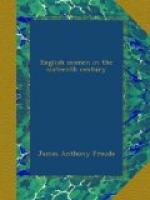I have in my possession a detailed account of the temper of parties in England, drawn up in the year 1585, three years before the Armada came. The writer was a distinguished Jesuit. The account itself was prepared for the use of the Pope and Philip, with a special view to the reception which an invading force would meet with, and it goes into great detail. The people of the towns—London, Bristol, &c.—were, he says, generally heretics. The peers, the gentry, their tenants, and peasantry, who formed the immense majority of the population, were almost universally Catholics. But this writer distinguishes properly among Catholics. There were the ardent impassioned Catholics, ready to be confessors and martyrs, ready to rebel at the first opportunity, who had renounced their allegiance, who desired to overthrow Elizabeth and put the Queen of Scots in her place. The number of these, he says, was daily increasing, owing to the exertions of the seminary priests; and plots, he boasts, were being continually formed by them to murder the Queen. There were Catholics of another sort, who were papal at heart, but went with the times to save their property; who looked forward to a change in the natural order of things, but would not stir of themselves till an invading army actually appeared. But all alike, he insists, were eager for a revolution. Let the Prince of Parma come, and they would all join him; and together these two classes of Catholics made three-fourths of the nation.
‘The only party,’ he says (and this is really noticeable), ’the only party that would fight to death for the Queen, the only real friends she had, were the Puritans (it is the first mention of the name which I have found), the Puritans of London, the Puritans of the sea towns.’ These he admits were dangerous, desperate, determined men. The numbers of them, however, were providentially small.
The date of this document is, as I said, 1585, and I believe it generally accurate. The only mistake is that among the Anglican Catholics there were a few to whom their country was as dear as their creed—a few who were beginning to see that under the Act of Uniformity Catholic doctrine might be taught and Catholic ritual practised; who adhered to the old forms of religion, but did not believe that obedience to the Pope was a necessary part of them. One of these was Lord Howard of Effingham, whom the Queen placed in his high command to secure the wavering fidelity of the peers and country gentlemen. But the force, the fire, the enthusiasm came (as the Jesuit saw) from the Puritans, from men of the same convictions as the Calvinists of Holland and Rochelle; men who, driven from the land, took to the ocean as their natural home, and nursed the Reformation in an ocean cradle. How the seagoing population of the North of Europe took so strong a Protestant impression it is the purpose of these lectures to explain.




